
Thursday October 12, 2017
It had been many years since we last dove in Baja, but in many ways, returning there was a homecoming of sorts. For starters, Baja was where we first met Greg, our inveterate travel companion, butler/gear guru and friend. This was on the Don José, a long-operating live-aboard dive boat in the region, then owned by San Diego-based Baja Expeditions, now sold. This was back (we think) in 1993, and was our first exposure to underwater photography. We wouldn’t take it up for a few more years, but Greg was already hooked. He was there with a group from Shedd Aquarium in Chicago, led by the booming-voiced Dick “Impact!” Jacoby. Dick brought styrofoam ice coolers full of Nikonos V cameras for his charges to use, as well as chemicals to develop E-6 slide film. Steve and I were not part of Dick’s group, but watched the nightly film reviews with dawning interest. We enjoyed Greg’s company, exchanged addresses and went our separate ways. That is, until we found ourselves together again on another live-aboard diveboat, completely unplanned, 6 months later, this time in Belize (on the years-later-to-capsize Peter Hughes boat, the Wavedancer). At that point, we gave in to the inevitable…this seemed a signal from the universe that we were destined to be friends and we’ve been traveling together ever since. This would be Greg’s first trip back to the region, while we had done a second, whale shark focused trip, on the Don José in 1999.
This was also a long-overdue reunion with other dive buddies. We had done a number of dive trips organized by Bay area videographer Skip Stubbs and San Diego photographer Phil Colla over the years, including to Guadalupe Island (before the advent of white shark cage diving operations) in 2003 and Galapagos in 2006. Every year, Skip would imply this might possibly be the last trip he would organize on the Ambar III, on which we traveled with Skip in 2004 on our first trip to Socorro (the Revillagigedos Islands). The Ambar III, captained by Mike McGettigan, aided by his wife, Sherry Shaffer, is a private boat, which served as the floating base of operations for Howard and Michele Hall when they were making the film “Shadows in a Desert Sea”. We hadn’t seen Mike and Sherry since our Socorros trip in 2004, as Skip would always invite us on the annual fall trip long after our calendar was filled (admittedly, we often plan over a year in advance). We had been horrified to learn of Sherry’s near-death episode of shallow water blackout in 2008. An accomplished free-diver, she was pulled lifeless from the water, 7-8 minutes after blacking out. Her discovery by their long-time deckhand, Edgar, successful resuscitation (4 hours of CPR) and the Ambar’s miraculous intersection with a faster boat (they were hours from a hospital), coupled with her waking up deficit-free the next day, are an amazing story of a veritable medical miracle.
So, it was for many reasons we looked forward to this trip. It turned out we would have to wait longer to see Skip again. Waiting to board our 2 hour Alaska flight to Cabo San Lucas, we intersected with Phil. Skip had just called him- the wildfires in the Bay Area were wigging out his wife and he wasn’t coming. On board, a culinary surprise awaited…the banh mi sandwich for purchase (menu by Seattle restauranteur Tom Douglas) was so delicious I was actually disappointed it wasn’t available on our return!
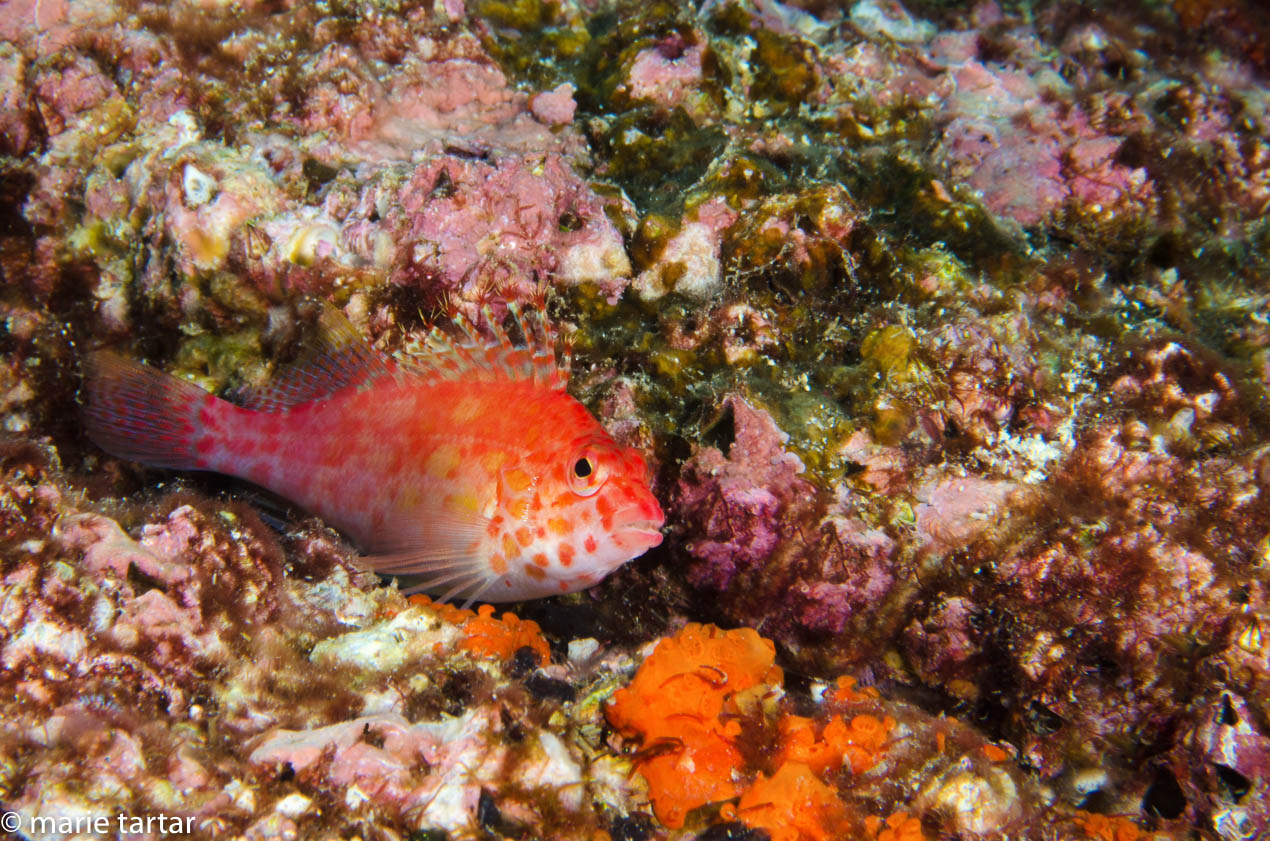
A signature fish species of the Sea of Cortez: the short-nosed hawkfish (Cirrhitichthys oxycephalus)
Greg was waiting for us at the airport in Mexico. On our 2.5 hour transfer north to La Paz, Phil told us an unbelievable story concerning a couple from Chicago we all had met on another “Skip trip”. We had heard that he had a serious stroke at an airline check-in counter, when the two of them were heading off on a dive trip, but had never heard any follow-up. I remember thinking a stroke would likely be career-ending for a pediatric cardiothoracic surgeon. It turns out that his girlfriend (and everyone) had been duped. After his stroke, she began trying to piece together his health insurance. Contacting his “workplace”, she eventually learned that not only did he not work there, but he was not even a doctor! When he was “at work”, he apparently was home with his wife and family.
Boarding the boat, we found the Ambar III, Mike and Sherry all looking remarkably well-maintained. One surprise change since our last trip to Baja: new restrictions on visiting Los Islotes. Memories of playful sea lions parting shimmering anchovies had been a powerful motivator for returning, so this was disturbing to learn. Visits to the islets apparently were suspended earlier in the summer due to snorkelers being bitten and the ability to visit was in flux. Mike proposed we head north to a “secret pargo hole” he knew.
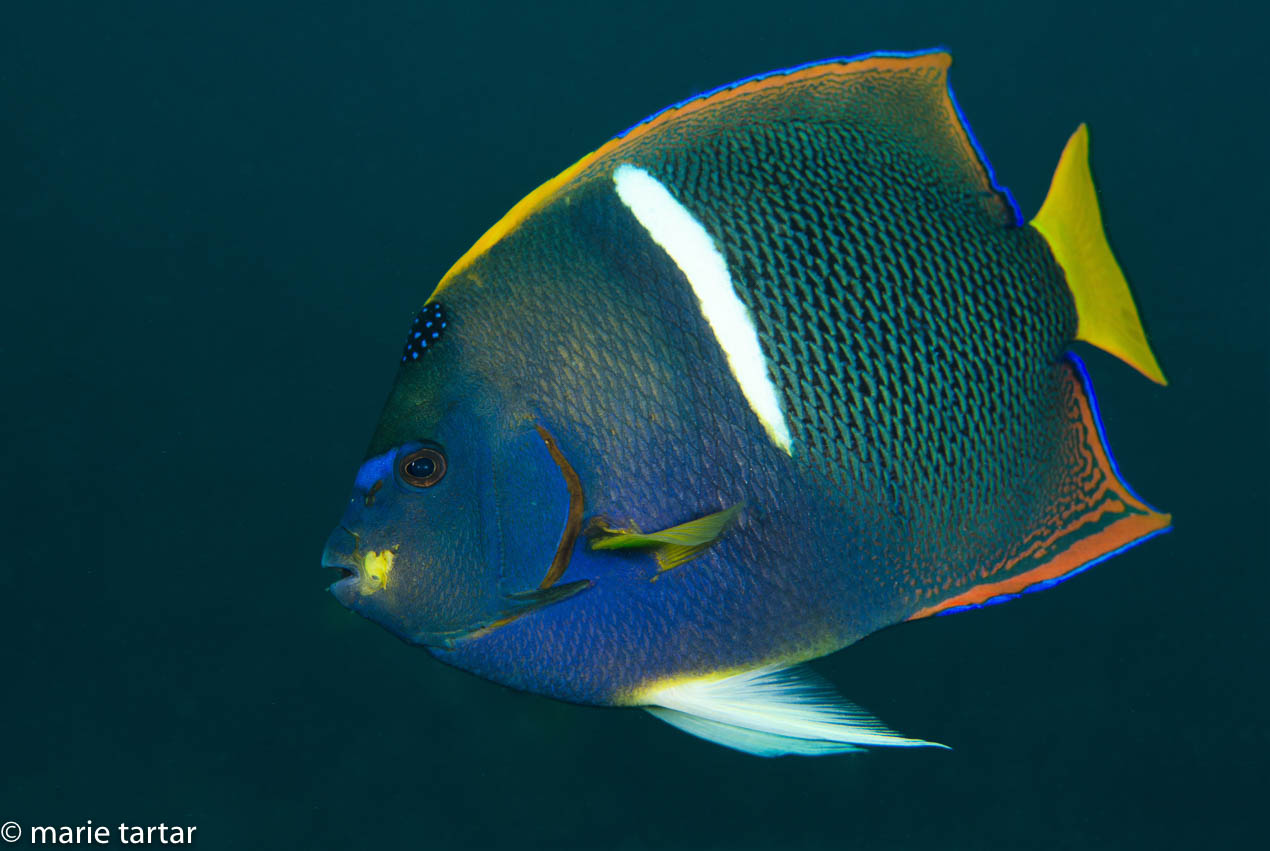
Another Sea of Cortez favorite: King angelfish ( Holacanthus passer), with a forehead crown of blue spots.
Friday October 13, 2017
The morning light was lovely when we ascended the stairs from our cabins below decks, prompting Steve to launch his new drone on its maiden voyage. That was another change from our prior trip…we had a fleet of drones on board. Greg and Phil also brought theirs, Mike has one, as does Leo(nardo), a Venezuelan photographer on board, who works with Mike on behalf of Sea Watch (more about Mike’s conservation watchdog group, Sea Watch, later).
We did 2 dives at the “secret pargo hole”. Although the chart predicted slack, the current was going, with the bow anchor taut at a 45 degree angle. To be sure of hitting our target, we took the skiff a few boat lengths up current. Steve and I descended with Sherry, while Greg and Phil entered with with Leo; the skiff will hold all of us, but gets a little crowded with the cameras, so we usually entered in two shifts. The top of the site was about 50 feet down, where we found some sizable eels as test subjects to dial in our wide angle exposures.
Seeing Sherry’s bright yellow fins toward the end of dive cued me in to where the anchor chain must be, which I hadn’t seen up to that point.
Although the current was strong the first dive, the second was much more peaceful. Steve and I entered with Leo, who led us to the pargo hole at depth. These big fish are shy and elusive to close approach. There was another small opening filled with fish, with an eel stretched out at on the bottom.
On board the Ambar, we are diving with steel tanks, in which a full fill is 2300 psi; I end up using a steel 80 the whole trip, while the men all opted for the steel 95s.
For the third dive, I switched to 60 mm macro; I went in thinking my battery was low but adequate, but ran out of power. The terrain was similar to Mike’s “32 foot spot”, a series of sand channels between rocky ledges and short walls with healthy and colorful gorgonians. The current was ripping. Luckily, there was some cover in the canyons and as the current shifted me from one hideout to the next, I saw the anchor line.
The current was so strong on the anchor line, that I found myself stretched out full length on the line, making me a little nervous to finally let go, not sure just how fast it would sweep me under the boat and possibly past, but I hit the ladder target perfectly. Phil was already up. Everyone else was washed off and picked up by Omar in the panga.
Omar is a relatively new deckhand and we quickly figured out he was learning on the job. He was willing, but inexperienced. Luckily, everyone on this voyage is very experienced, and we quickly figured out we had to verify our air was on, not off. Of course, this is something we should always do, but it’s easy to become lax in the hands of experienced skiff drivers.
Greg had a scare during the sunset drone flight, losing communication with his bird for an extended period, at least 10 minutes. It was so long, we all thought it was gone, but at long last, it reappeared on his screen. We learned from that not to drop the drone down on the other side of mountains or island ridges, out of the line of sight.
Saturday, October 14, 2017
We anchored near Isla San Diego. I ascended to the back deck to find it was drone fleet week, with Steve, Greg, Phil and Leo all with drones aloft simultaneously; I launched a short flight afterwards.

Panamic cushion sea star (Pentaceraster cumingi), covered with tiny brittlestars, Sea of Cortez, Baja
We dove a rubble field under the boat, the Baja equivalent of a muck dive. My most colorful finds were Panamic sea stars (Pentaceraster cumingi), which in this region were covered with miniature brittlestars. After I caught a glimpse of a matching shrimp disappearing underneath, I took to inspecting their undersides, often finding several color-coordinated shrimps.
Although I was careful to return them to their original positions, it soon became clear they were perfectly capable of righting themselves and surprisingly quickly. A free-swimming green eel romped across the plain.

One of the most delightful miniature finds of the week! A plume blenny (Cirriemblemaria lucasana) with a characteristic tuft of “bad hair” like cirri. 
Bluespotted jawfish (Opistognathus rosenblatti)
Dinner was a delicious, familiar standard, the Silver Palate’s chicken marbella, with a quinoa and rice mix and salad. One of the many highlights of life on Ambar is Sherry’s cooking, which is healthy and consistently delicious. She is a veritable culinary magician, with her favorite ingredients being capers and olives, which she deploys with delicious results.
In the evening, Greg introduced Steve to the film “Get Out”, while I finished Angels in America, the seminal 2 part play by Tony Kushner set in New York’s gay community during the worst of the AIDS epidemic. I had applied (with our friend Gail M) to invest in the 25 year Broadway revival next spring, which sold out last summer’s National Theatre run in London in a record one day! We didn’t win the lottery to participate, but I’ve lined up tickets to see it on 2 consecutive weeks next April and will watch its performance with interest.
Sunday, October 15, 2017
We again dove the rubble under the boat, adjacent to Isla San Diego. I had an alarming message flash in my camera once underwater, to the effect “this card may be damaged”; I elected to format it.
For dive #2, we repositioned to the southeast corner of Isla San Diego. Here, the topography was more interesting, with short rocky terraces. There was another free swimming eel. Greg showed me what I took to be tiny nudibranchs bound up in yellow algea; they turned out to be miniature seahares. Steve had a nice find of a charismatic blenny on a mini-wall.
For our final dive of the day, we returned to the “32 foot spot” (although I never did find any portion of this site that shallow, I’ll take Mike’s word and the radar evidence that the name is accurate). It is a beautiful fishy wide angle spot, with many gorgonians and sea fans, a series of small canyons. I again navigated back to the anchor by following Sherry’s yellow fins.
Sherry’s pargo veracruz had to make a return trip back to the oven before being served, but it was ultimately scrumptious.
Steve and Greg decided I also had to watch “Get Out”, so they started it again. I really enjoyed this unusual race relation/ urban horror flick by Jordan Peel, so was glad they insisted. Greg and I started a second film, “Menashe”, unusual in that it was secretly filmed in Brooklyn’s Orthodox Jewish community and is a rare film with much of the dialogue in Yiddish. The title character is a sad sack, well meaning, but hapless. He is a widower trying to oppose the community’s strict edict that children must be raised in a home with a mother. His wife’s brother is pressuring him to remarry, and in the meantime removes Menashe’s son to his own household.
Monday, October 16, 2017
After an early drone flight, we had a lazy, in transit morning. We dove twice, at midday and in the late afternoon near Isla San Francisco. We could see there were photogenic salt ponds on the opposite side of the island from beach, revealed by drone. There were several other boats anchored nearby. We were a little leery of a jet skier and wave boarder zooming around.
A large school of spottail grunt (ronco soldadito) wavered near the fringe of huge boulders along beach. Multiple large green eels (Panamic green moray; morena verde) were free swimming among the schools of snapper and Sargeant Majors, while damselfish were nesting. Greg found a lovely zebra eel (morena cebra). But perhaps the greatest treasure was unearthed by Leo, underneath the boat, a displaying male signal blenny.
Dinner was around the round table on the back deck, an arrachera cookout with roasted vegetables, cumin beans , rice, salsa and tortillas, a Sherry specialty. This savory marinated meat is so delicious, this is what Mike and Sherry’s family requests they bring back with them when they return from their yearly extended stays in Baja (usually 8-9 months of the year).
Greg and I finished watching “Menashe” outside on the upstairs deck, under a gorgeous milky way canopy.
Tuesday, October 17, 2017
We repositioned to Las Animas, where we did 2 dives. The first dive site resembled a miniature Roca Partida. By drone between the dives, Steve found a raft of sea lions near the bigger rock, so that was where we headed the second time in. Surgeonfish were energetically feeding, while wrasses were actively spawning, sending clouds of gametes into the water column.
Having located sea lions, we entered the water with the intent of sidling up and seeing if they were game for interacting. At first, they were quite elusive, edging away on any attempt to approach them. That is, until Greg doffed his gear and began free-diving, which seemed to attract their interest favorably. This dive terminated strangely, near the end of the islet, in a swirling vortex of bubbles amid a mild downdraft.
When the day’s diving was done, I finished A Gentleman in Moscow by Amor Towles. My sister had recommended this fictional account of a Russian count turned head waiter, set in Moscow’s esteemed Metropole Hotel, to which the count is sentenced to house arrest for decades, as the social order of Russia is turned upside down by the Revolution. The timing was peculiarly appropriate, as this month is the 100th anniversary of the Russia Revolution. We had a drink at this hotel, conveniently near the Bolshoi Theater complex, when we were in Moscow this past summer. This was a very fun read, a charming lens through which to view the sweeping changes which transformed Russia. Just as the count must re-engineer himself to changing times and mores, the author is enjoying success in a second career as a novelist, his first as an investment professional.
Our transit to a secure anchorage was interrupted by tugs on the fishing lines trailing the boat. Steve did the honors reeling in the first of two catches, a dorado, only slightly wrenching his flinchy back. Later, a magnificent wahoo was hauled in, which reappeared later in another Sherry signature dish: wahoo parmesan!
Wednesday, October 17, 2017
Return to the “32 foot spot”. As we were suiting up, we noted swirling patches on the surface, signifying strong current. Although a patch of the reef was visible alongside the boat when we entered, it was decided to drop us up current by panga. Phil and Greg went in first, followed by Steve and me. Sherry donned her thermal suit, but decided against going. Bobbing up from a backward roll into the water, I had to kick hard to grab a pontoon to not drift away while Omar handed over my camera.
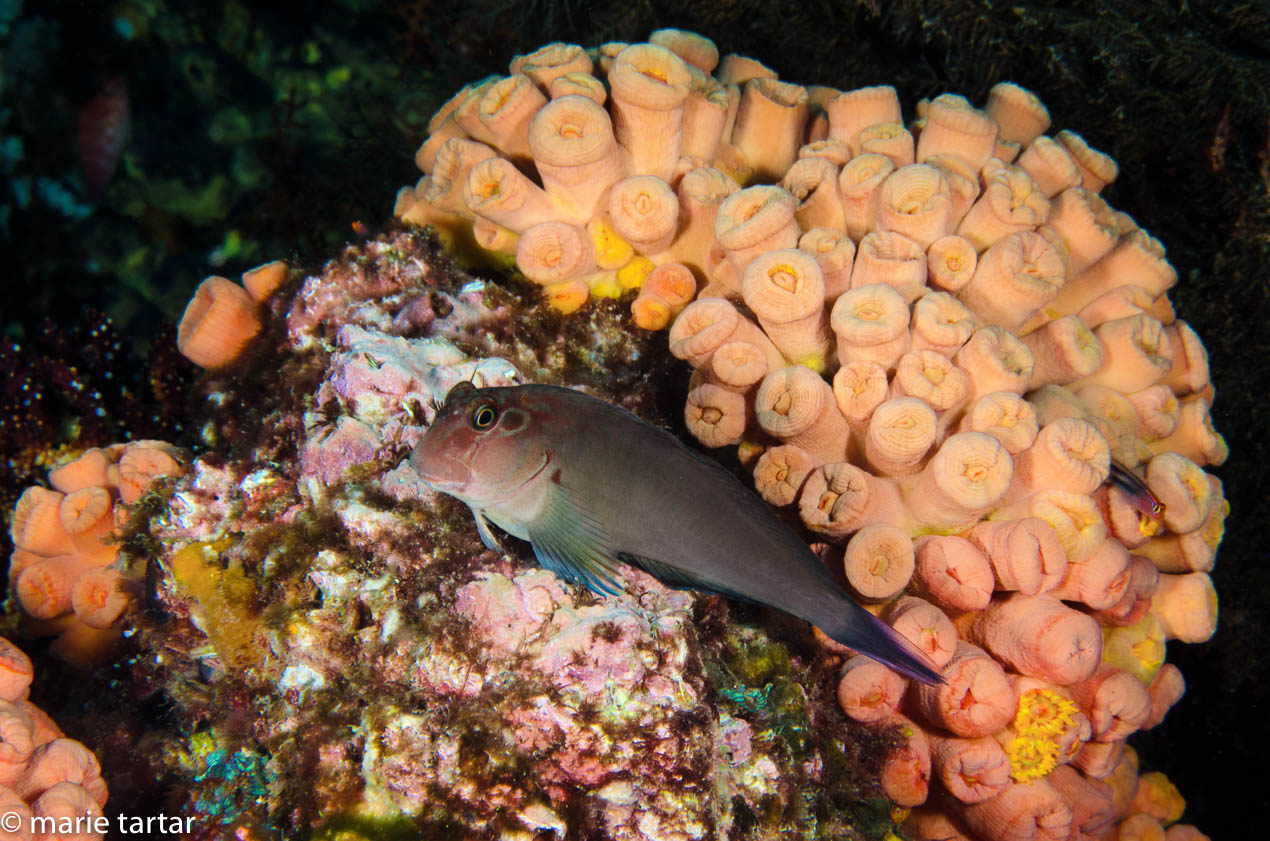
Panamic fanged blennies were abundant! (Ophioblennius steindachneri); this is a juvenile. In the background, a clump of Tubastrea coccinea, which “blooms” beautifully at night.
Looking down, I could see Phil and Greg on either side of a run of reef. I descended into a relatively sheltered enclosure at 60 feet near Greg. Once I had a reasonable wide angle exposure dialed in, I began to realize I couldn’t easily go anywhere. Going up, I could feel the inexorable tug of the current. Trying to move into another canyon was not too easy. When I first descended, I noted the proximity of the anchor line to the edge of the reef. So, I was surprised not to see it when it came time to ascend. I ended up following a line in the sand, suspecting we had drug anchor. Sure enough, eventually I saw the anchor and the line and swam hard to catch it. Hanging on the line was not pleasant. The current pulled hard, stringing my camera like a sea anchor behind me. My mask wobbled threateningly on my face. I had to face into the current, lest my mask be ripped off. I had no third hand to press against the upper edge of the mask to exhale out the accumulating water beginning to obscure my vision. Nor could I reach or bring up my console to read what depth I was at or how much air I had left. The inexorable suck of the torrent dragged me higher and higher up the line, until I was at the surface. At that point, I had no choice but to let go, face the boat and concentrate on grabbing the ladder at the back of the mother ship.
Leo went in after us and aborted, indicating the current strength was too much. He is a lot younger and stronger than the rest of us, and dives Cabo Pulmo regularly, so that is saying something. It was a new moon.
Our second dive attempt was a not-so-far-run-away rubble field. I say attempt, because I aborted the dive early. We entered from the stern. It was 40 feet down and I could already see the gap between me and the boat’s shadow was growing…quickly. The rubble field offers no shelter or handholds. My metal stick was useless in this situation. Letting all my air out, I could lay in one position on the bottom, even potentially shoot. But trying to reposition to search for a subject? Almost impossible.
I napped during the third dive, to the other side. This ended up working out well, as I had no bottom time issue doing a dusk into night dive back at the “32 foot spot”. Phil and Leo were already on the reef when I arrived. It was now calm enough to really enjoy this beautiful setting, set off by streams of schooling fish in evening rush hour mode , and opening clumps of orange tubastrea.
I saw Phil’s light as he ascended, appearing so fixed in position I thought he must be on the anchor line. This wasn’t the case at all, he was trying to hold position near us in mid-water. I had been dropped up current of the boat and anchor line and ended up on the opposite side of the Ambar, having been swept along once I began my ascent, despite trying to maintain visual contact with the reef.
Thursday, October 18, 2017
was spent near a small fishing village, on the north side of Punta Alta. It was sunny and calm.
Under the boat, I found myself in a featureless rubble field at 60 foot depth. At first I didn’t see much, then recognized the outline of a sand-covered ray, given away by two bulging eyes. This proved to be a large Bullseye electric ray (Diplobatis ommata). When it bolted from its sand hiding place, it headed down reef. Where it landed seemed to be a ray meet-up, with a cluster of 6 smaller bullseye electric rays.
Swimming toward the shore, looking for a subject at a shallower depth, I found Steve and Greg. Steve had found a Finespotted jawfish (Bocón Punteado) in a well constructed, shell lined hole in the sand, near the boulders at the shore.
While Greg hovered expectantly, Steve explored a nearby miniature bommie. Waving me over, he pointed out a tiny Jewel moray (Morena pinta), with its head barely projecting from the rock. There were piles of shells, evidence of an octopus in residence. Greg later found it, using the shells as cover.
For our second dive, we elected to be dropped towards the point where Leo and Sherry had started their first dive, lured by Sherry’s description of a large jawfish she found at 40 feet. As soon as we entered, it became apparent there was a formidable current with which to contend. It was clear we wouldn’t be swimming up to the back swim deck, as they had. Not getting swept further away from the boat was work enough. It seemed the deeper, the stronger the current, so my dive was spent at 40 feet and shallower. Greg found a little octopus. We didn’t find Sherry’s jawfish, although Phil did find ours from the first dive. In the shallows, there were large rocks and occasional huge boulders. I spent the last segment of the dive sheltered from the current in the lee of a boulder so large it reached up to the surface. Tiny blenny heads (Mexican barnacle blenny) jutted out of worm holes, punctuating the colorful rock surface.
We spent late afternoon and evening in Cayo, a rocky spit of an island. Steve was the only one to do a 3rd day dive, leaving his drone unattended for me to fly. For a virtual fly-over, here’s a video link: https://vimeo.com/244561296
The rest of us conserved our energy for a night dive.
We had dinner when Steve returned from his dive and before the rest of us suited up, shrimp and scallop pasta. Sherry is a culinary wonderwoman with olives, capers and tomatoes.
The night dive was a night of marine horror. Conditions were good for a night dive, a slope of large boulders, ending in sand at about 30 foot depth. The piled up boulders created an endless series of connected tunnels and swim throughs. As soon as I descended, I saw a brownish blob I took to be an octopus at first. But wait, rhinophore-like horns up front, a sea hare. They were everywhere. Synaptic sea cucumbers were sprawled on every surface. Large green morays slithered around and under the boulders.
Friday, October 19, 2017
We headed south, towards La Paz and the end of our trip, making it it to Espiritu Santo. This coastline is lined with very sculptural sea stacks. We did a very shallow, long dive at The Aquarium, where there are huge boulders reaching to water’s surface. It is a pretty place, with many colorful Sargent Majors, surgeonfish, parrotfish, and wrasse, to enliven the scene.
It was so pretty that I was changing over to wide angle before lunch when we received word that Baja Expeditions was sending over a dive guide. Mike quickly dispatched Leo and Omar by panga to meet Debi, a divemaster from Switzerland. For $55/person, we were now officially authorized to dive Los Islotes! Memories of playful sea lions parting shimmering curtains of silvery anchovy schools were a primary motivation for returning here.
In the old days (the 1990s), we spent days anchored near the connected isles of Los Islotes. Now, access to Los Islotes is controlled. It isn’t entirely clear why there is the current push to regulate visiting Los Islotes.The authorization itself seems in active flux.
We can’t enter at the west end now, where the sea lions haul out, so we drifted there, past a barracuda school.
There were anchovies, but fewer than I remembered. Sea lions occasionally zipped by. One sun-filled shallow space occasionally played host to a pausing or playful sea lion.
Greg and I found a shallow platform with a playful performer, who gnawed vigorously on the gorgonians, possible for our benefit. A companion zipped in later, doubling our delight.
Cabrillas congregated at the corner, which Phil had never seen before in years of visiting here. Back around the corner, we found Steve with Debi, being entertained by a playful pup, repeatedly picking up and dropping a starfish, racing from the base of the narrow channel to the surface and back, over and over. It was a difficult shooting situation, as I could only see the light-colored starfish to focus, and not the dark sea lion in the dark rock corridor.
We return to Espiritu Santo, the site of our morning dive, for a night dive. Steve, Phil and Greg set off in the panga’s first run. It seemed a long time before the panga returned for me, Debi and Leo. Omar brought the news that Steve had had to enter the water with one of his large fins and one of my mediums. That left me with only one fin. We searched the panga, the dive platform, everywhere, to no avail. Sherry produced her bright yellow fins which fit me fine.
Steve surfaced when we stopped the panga near the pools of light at the inlet site of the night dive, expecting to exchange my fin for his. He didn’t understand until back on the Ambar that his fin had somehow gone missing. The Case of the Missing Fin has yet to be solved.
We had dinner around the table on the back deck, sushi and wahoo and tuna sashimi, with a cold Asian-influenced noodle dish.
Saturday, October 21, 2017
Mike isn’t allowed to anchor near Los Islotes in the new regulatory era, so we loaded up with 5 divers and 4 cameras and set off suited up for a punishing run by panga.
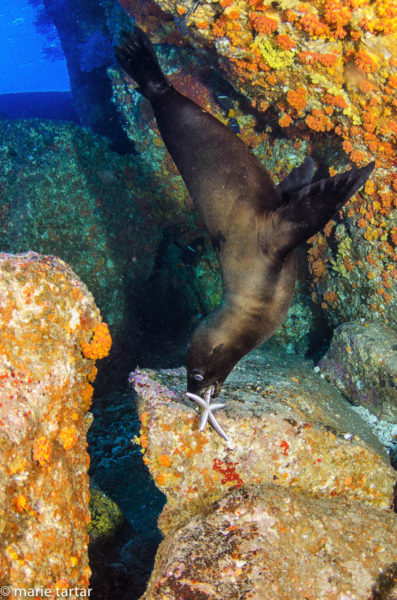
Fun with a starfish!: Playful sea lion pup in the swim-through at Los Islotes, Sea of Cortez, Baja Mexico
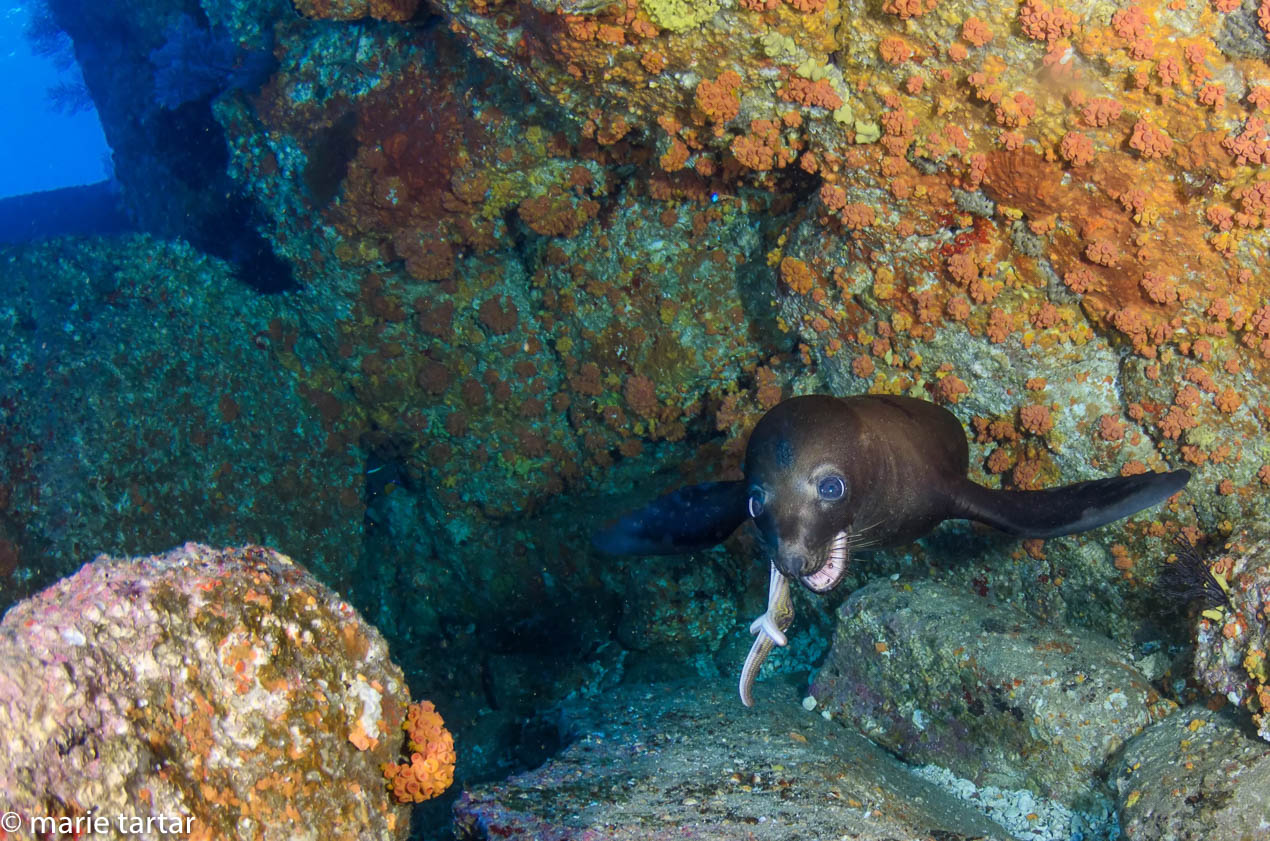
Starfish seemed to be the favored plaything of the sea lion pups, but they have been known to nibble diver’s fins and snorkels.
It was a relief to arrive and plunge into the cool, remarkably clear blue water. Phil said later these were the clearest conditions he had ever encountered there. We spent most of our dive at the tunnel, a swim through with colorful sponges and barnacle and tubastrea studded walls.
The sea lions appear so suddenly and unpredictably that we twist and turn, craning our necks upwards and still are continually surprised by these apparitions. Up in the shallows, a pup played with a sea star. Trying to hold position was challenging, trying not to let the surge and waves bash one against the barnacles.
On the north side of the tunnel, the fun continued, with pups on the surface. Steve had a prolonged close-up encounter with a tired appearing mom, appearing to take refuge in her quiet spot away from the rambunctious pups.
When we surfaced, we had lots of company, with 9 additional day boats having arrived from La Paz.
We spent a happy final afternoon diving San Rafealito, a smaller sea lion rookery en route back to the marina in La Paz. Steve, Greg and I went in with Debi. While we were occupied with a small raft of sea lions, she swam around the rocky outpost and found an even better vantage point, with a larger raft, coral encrusted rocky ledges and clear blue water, as well as the afternoon sun to our backs. To virtually float with a raft of sea lions, here’s a little video link: https://vimeo.com/244564039
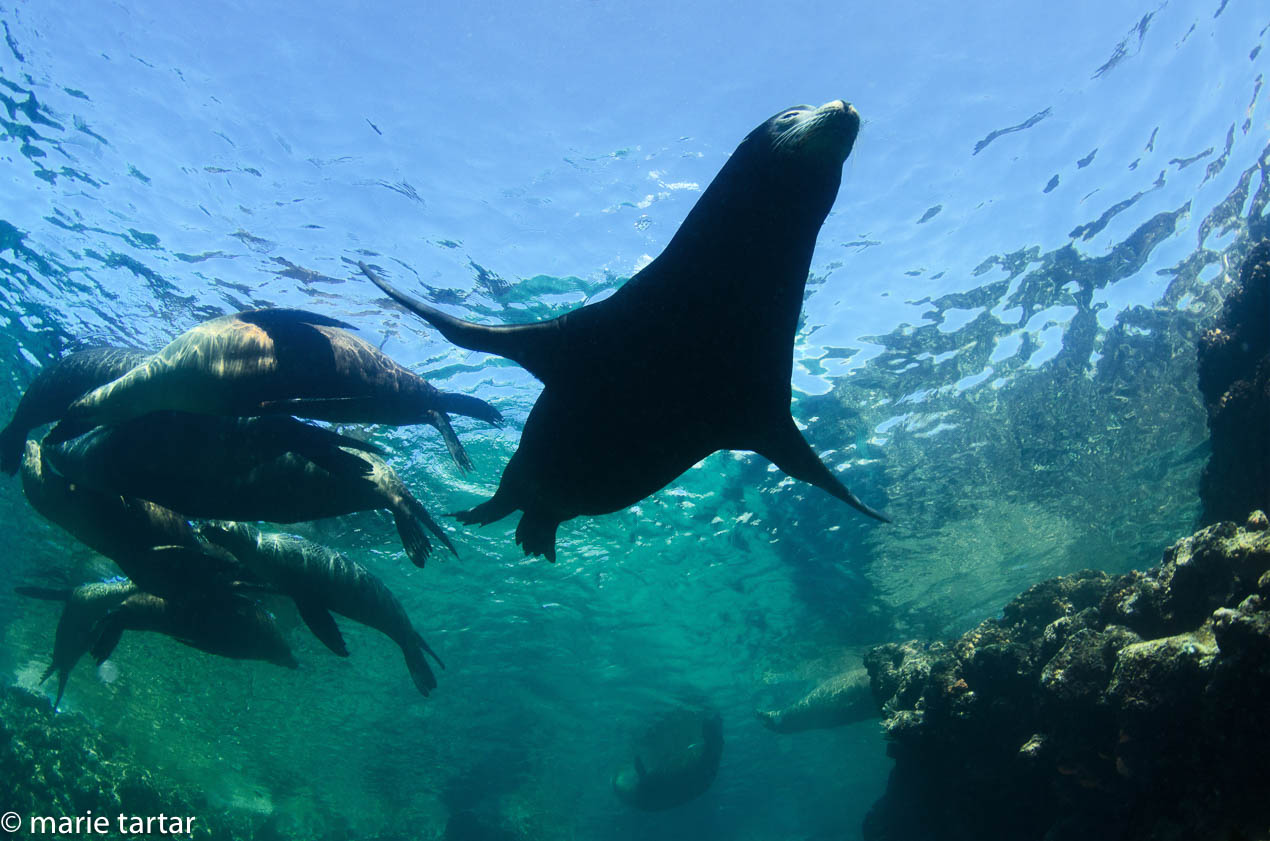
Large bulls, male sea lions, can be territorial, barking and charging, playing “chicken”, but this bull was quite mellow at San Rafealito, in Baja’s Sea of Cortez.
Leo and Phil went in after us but beat us back, thanks to Greg disappearing when it was time to call the dive. I think he wanted to stay underwater and I imagined how much I wouldn’t enjoy trying to break the news to his mother that Greg didn’t come back. Just then, he appeared and it was time to head back to the Ambar, back to La Paz for the evening and the following morning, back to our real lives.
On the Ambar, we’d been reminded of the boat’s, Mike’s and Sherry’s role as floating headquarters and logistical support for Howard and Michele Hall’s 1992 film “Secrets of a Desert Sea”. Returning to San Diego with Baja freshly in mind, we fired up the film for a look back at the Sea of Cortez in an earlier, more plentiful era. Although I thought we had seen the film, I didn’t remember very much specific, until the final truly horrifying scene, in which a shrimp trawler literally rakes the ocean floor, catching every manner of creature in its wake and destroying the reef infrastructure. Worst of all, was that the intended target was but a small percentage of the life captured, with the “by-catch” being thrown away as worthless.
In contrast to our episodic trips to Baja, Mike and Sherry have an unusually long-term perspective, based on their long and consistent tenure in Baja, spending a majority of the past 35 years on board the Ambar III cruising the Sea of Cortez. We heard their first-hand accounts of the changes wrought by rampant illegal and destructive fishing practices which focus on harvesting short-term profits, with no concern for the long-term health of fisheries. Alarmed by these trends, Mike formed Sea Watch (www.seawatch.org) in 1993, in an effort to stem the seeming inexorable pillaging of the sea. Their efforts have been multi-pronged, with educational, legislative and enforcement ventures which have enlisted participation of the local populace in managing a vulnerable resource. These efforts include the successful banning of the use of compressed air (often by hookah, surface based divers) in fishing operations in Mexican waters. The enforcement arm is ROC (Red de Observatorio Ciudadano) (Citizen Observer Network), in which regular patrols are made looking for illegal fishing operations. An educational campaign now is recruiting grocery store and restaurant owners in La Paz to pledge not to serve parrotfish, which is almost exclusively illegally harvested by hookah at night, as they sleep.

Parrotfish spin a mucus covering at night; they are vulnerable to collection at night, most of which is conducted illegally, using hookah surface-based compressed air systems, which enable fishermen to stay underwater for hours.
There is hope for these admirable efforts, judging by the success story of Cabo Pulmo, further south between Cabo San Lucas and La Paz. Cabo Pulmo is the only site in the Sea of Cortez in which the seemingly inevitable fishery declines have been reversed, thanks to a citizen-led campaign. The “Espiritu Santo es Parte de Tí” campaign is modeling itself on Cabo Pulmo’s success, which dates back to the formation in 1995 of the Cabo Pulmo National Marine Park.
Based on Leo’s photos and videos of Cabo Pulmo which we saw during the week, we’re planning a return trip to Baja next year. Per Leo, the first 10 days of October and November are the optimal time periods for diving Cabo Pulmo. Mike and Sherry hope to join us, and I’m looking forward to seeing a true environmental success story. In the meantime, my daydreams will be floating rafts of sea lions in clear blue warm water in sunny Baja.
-Marie



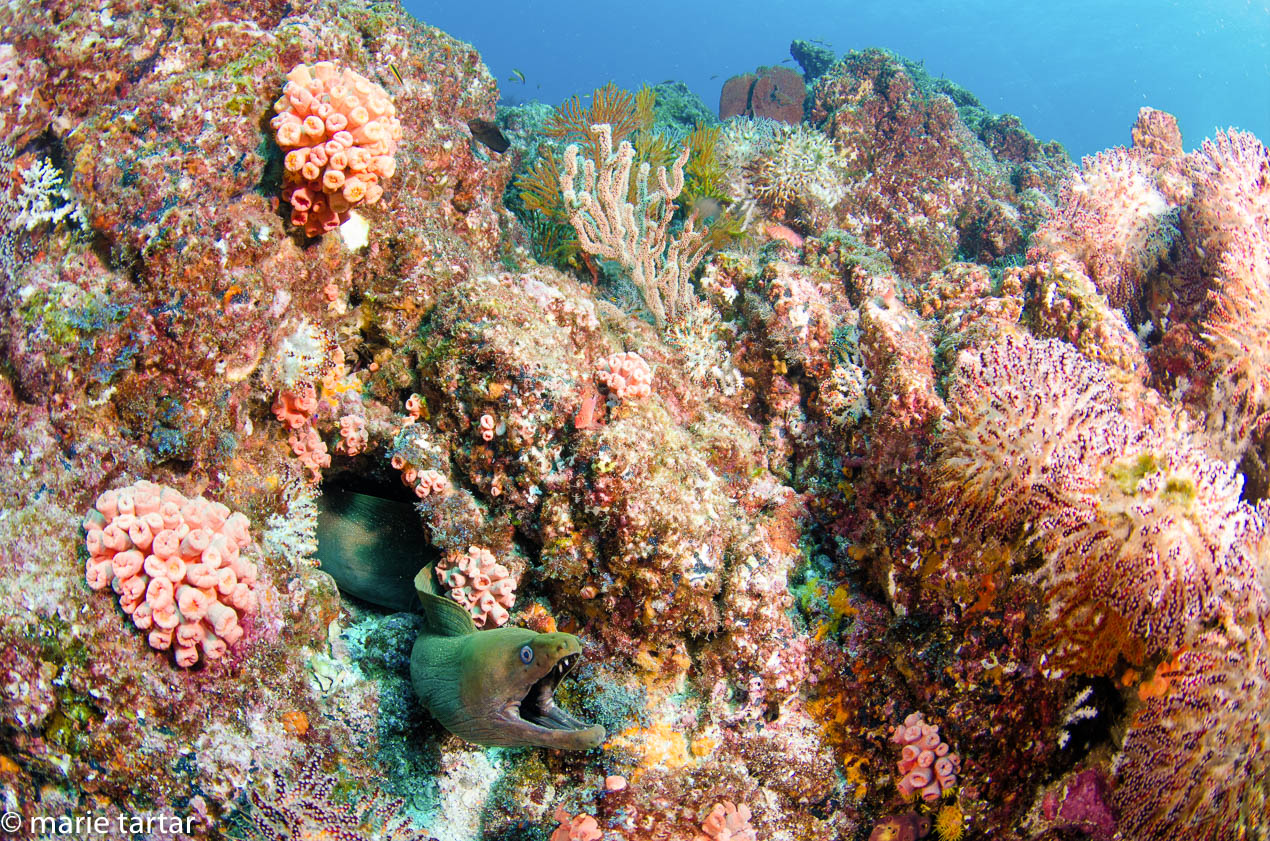

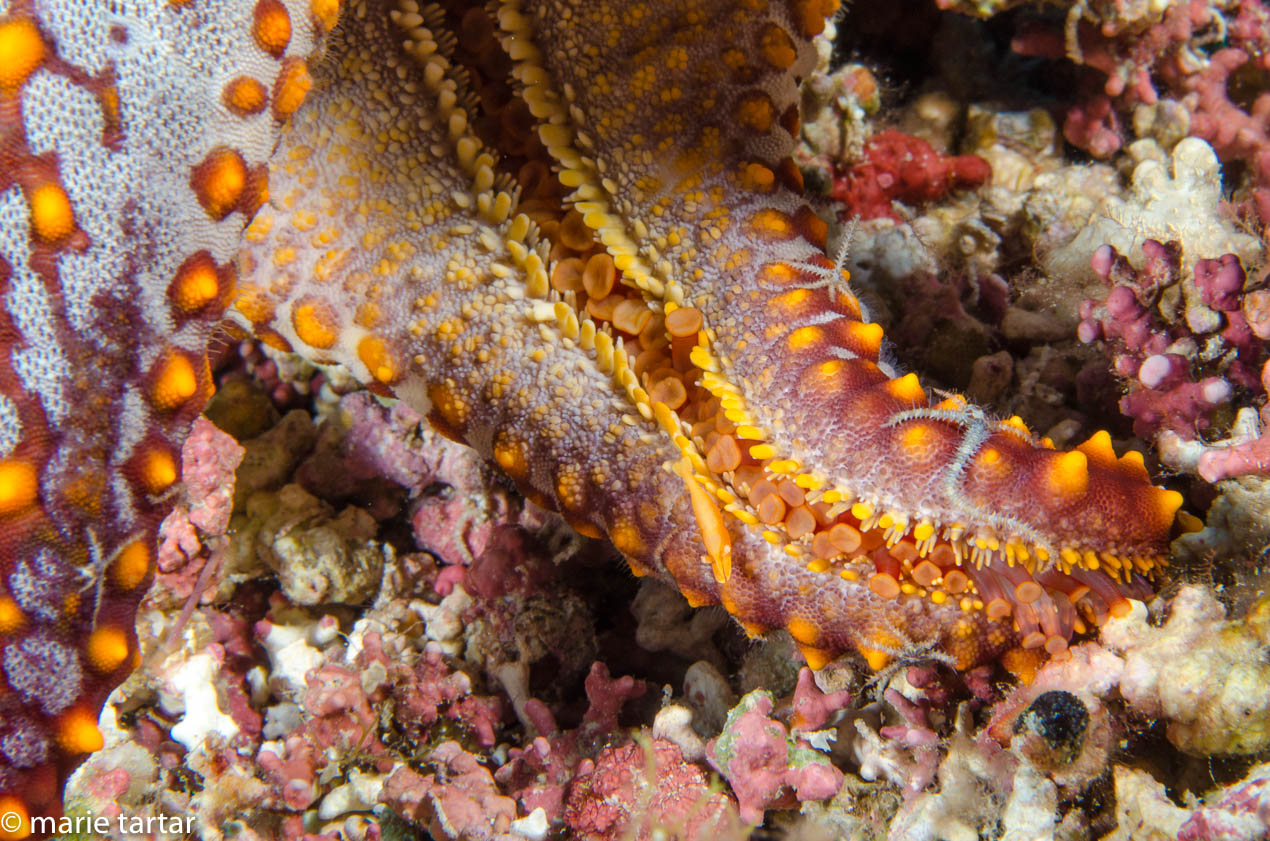

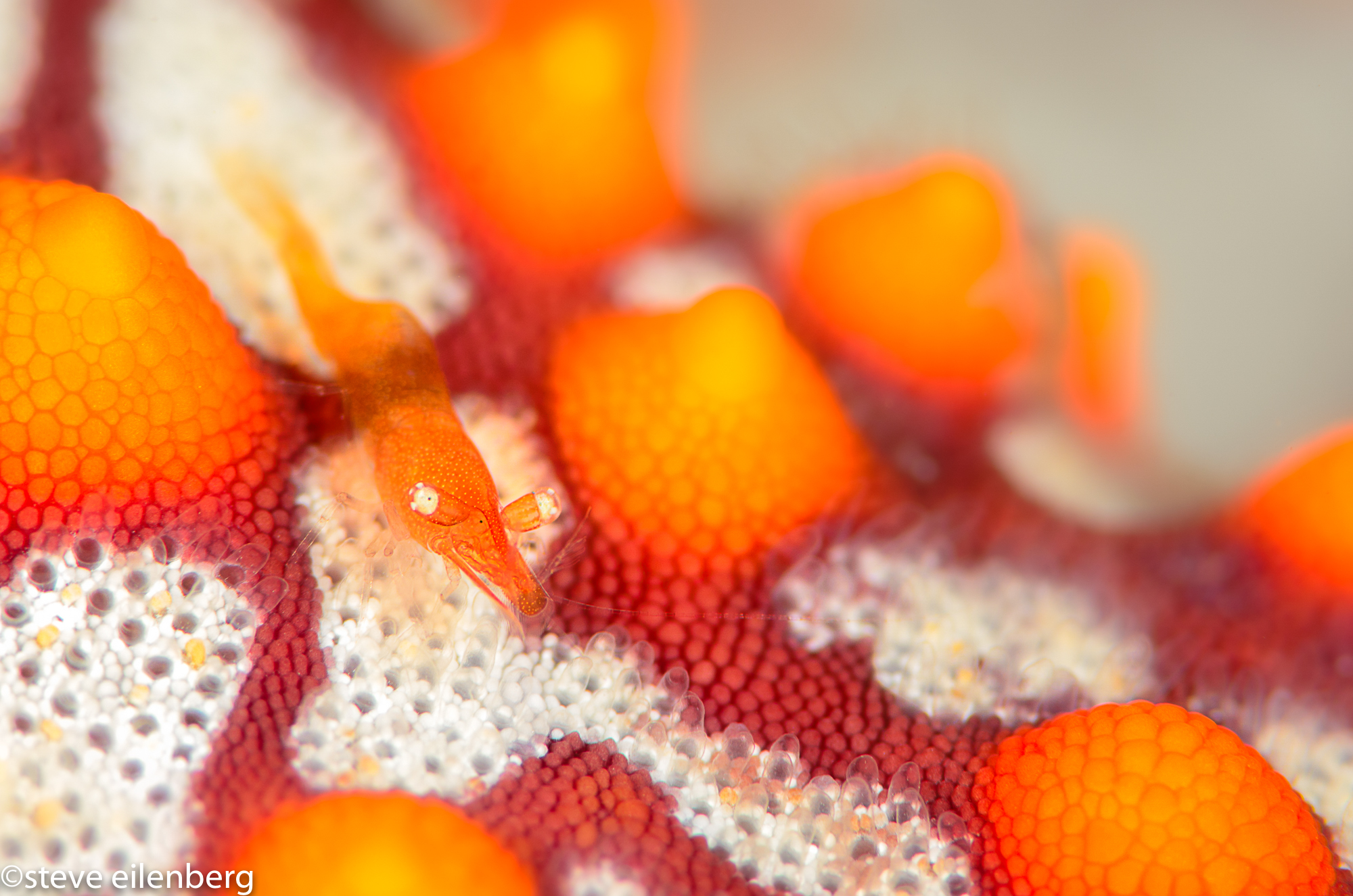


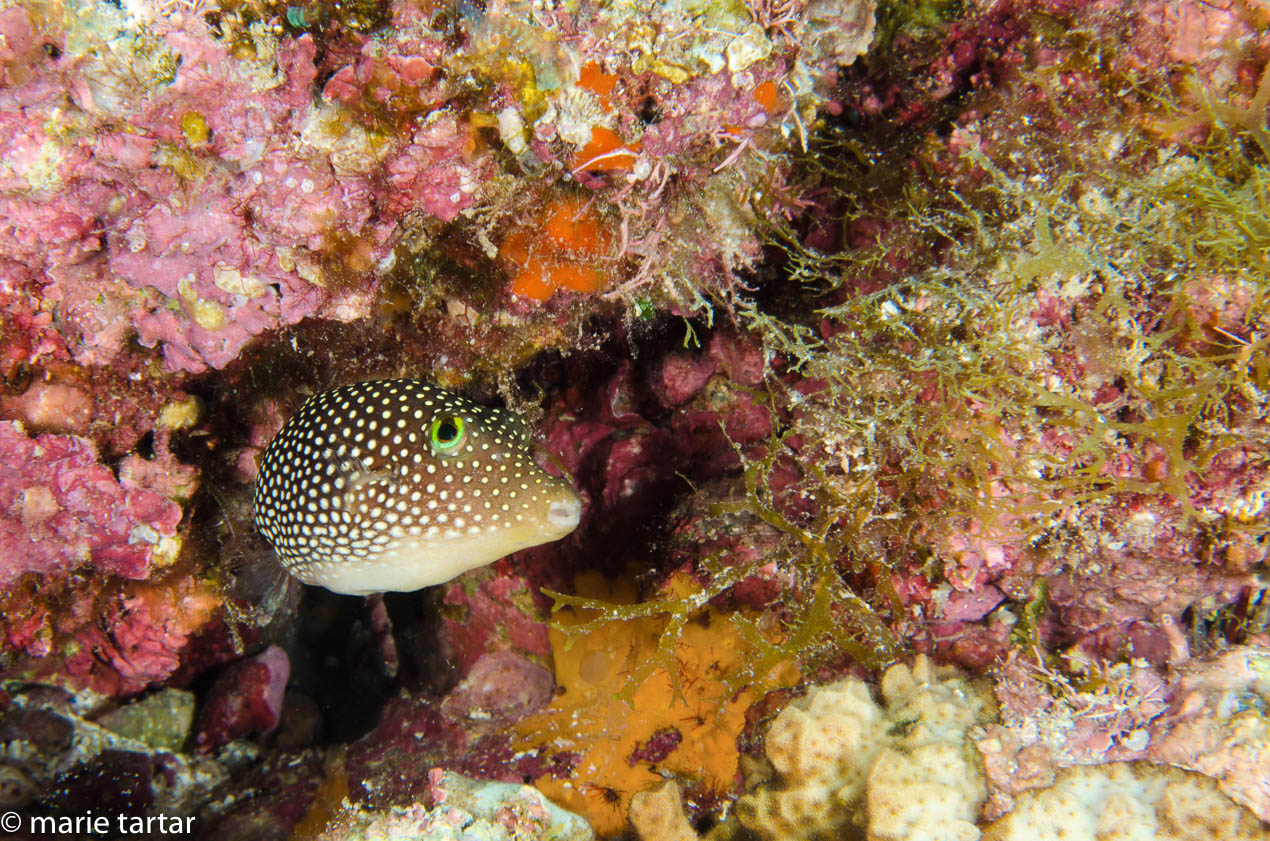
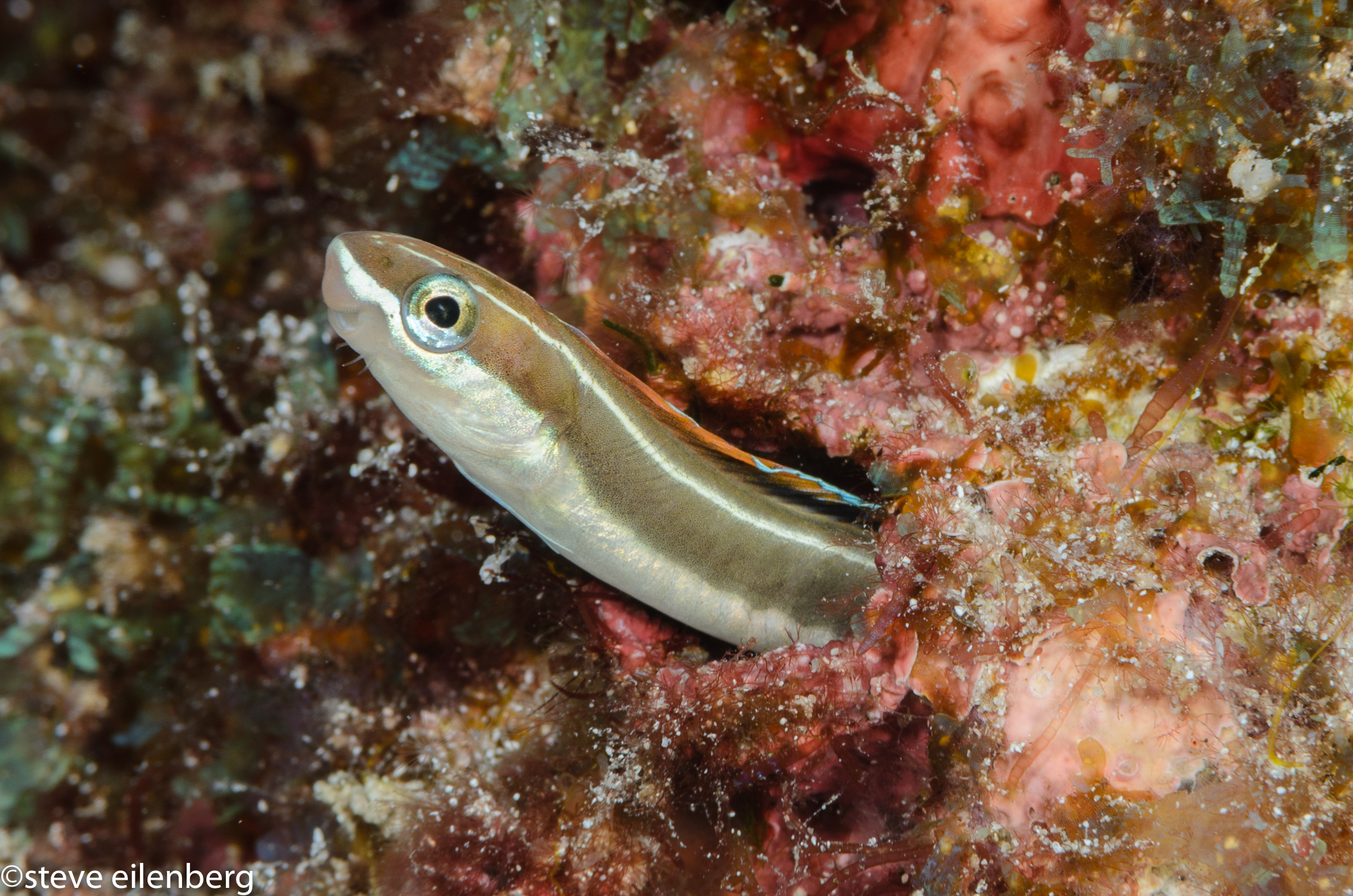






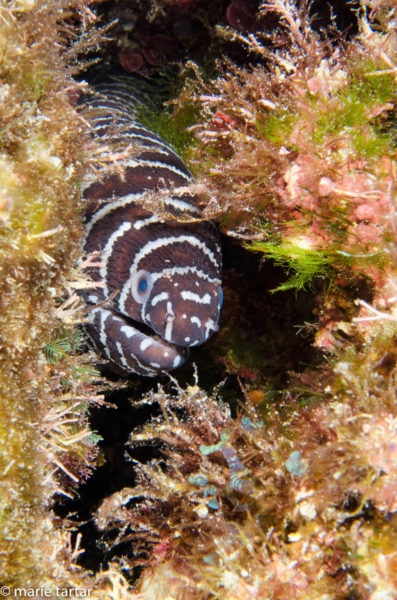


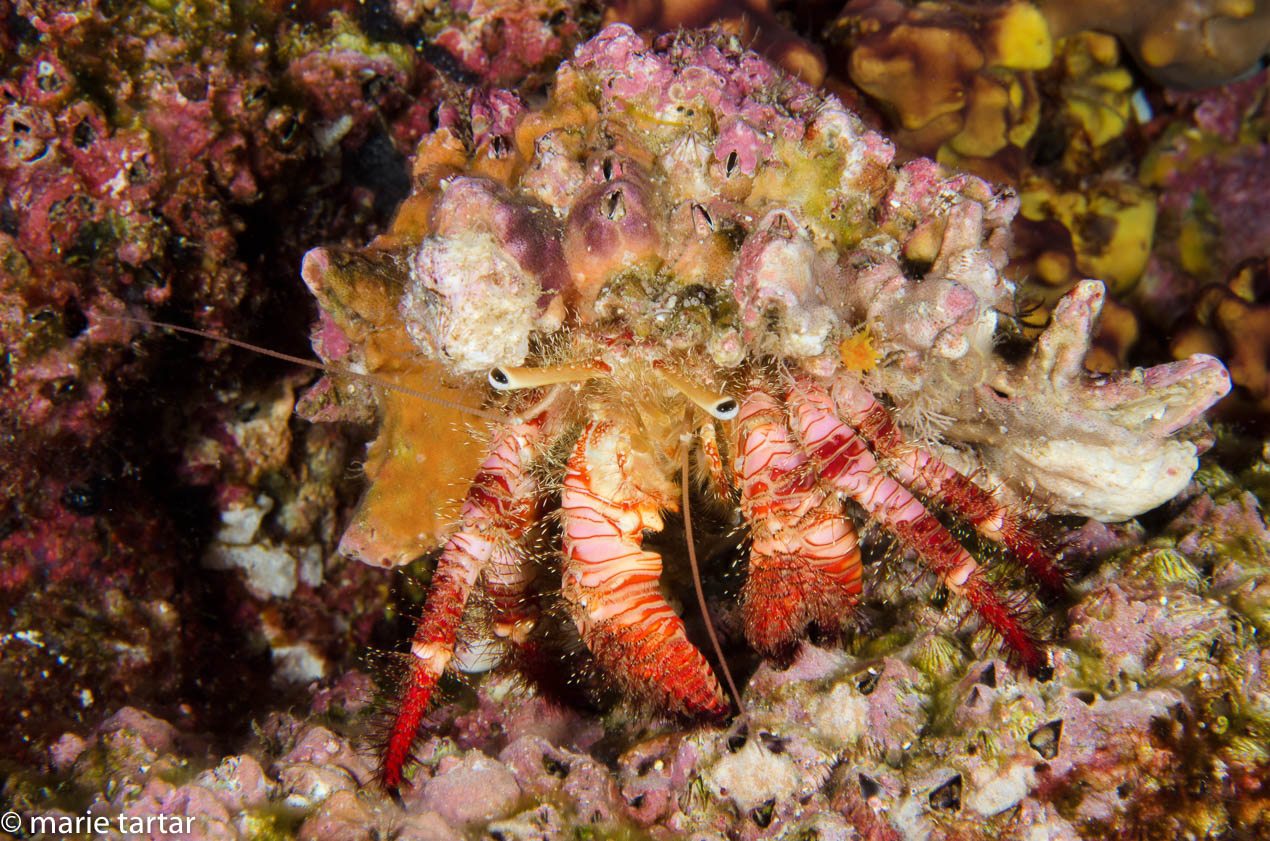

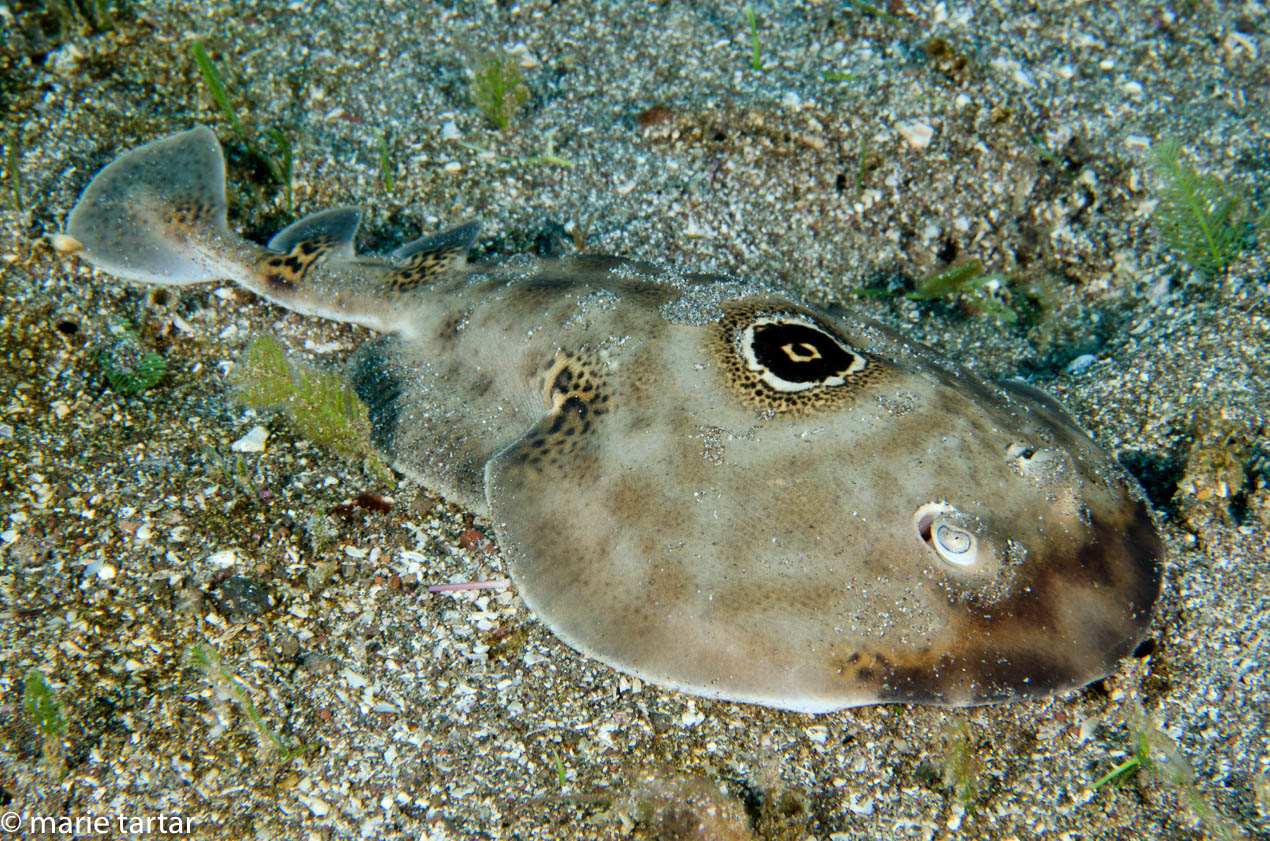
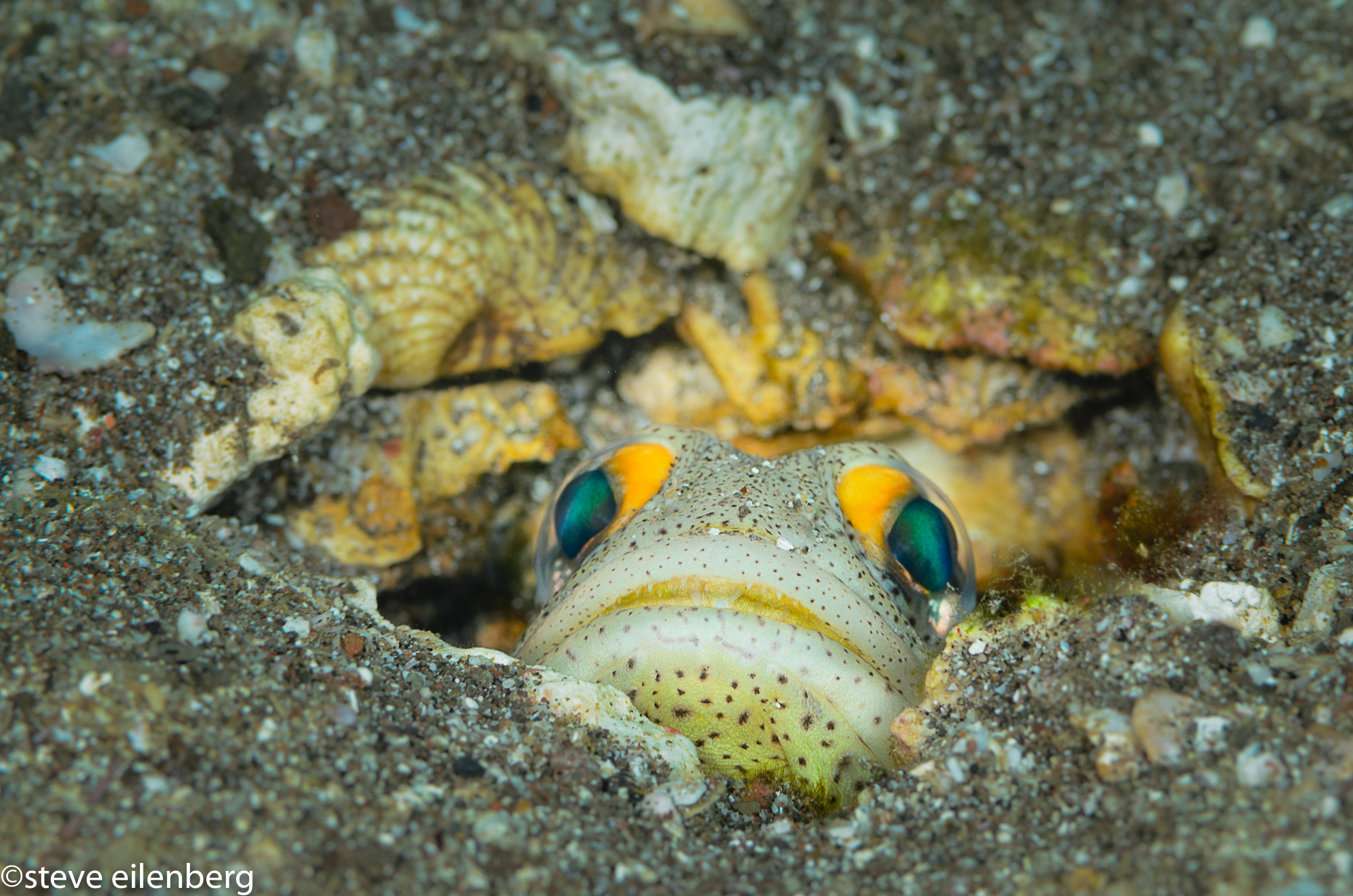



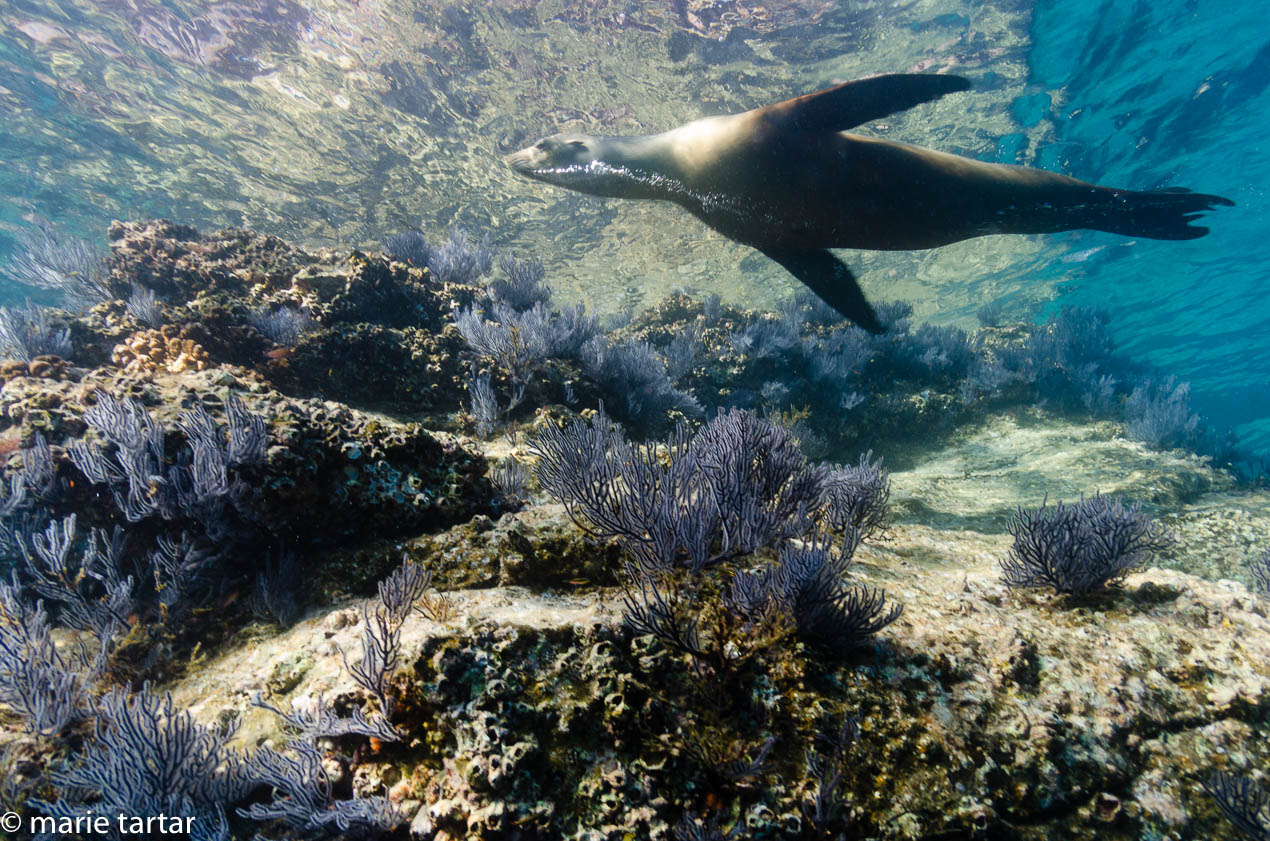

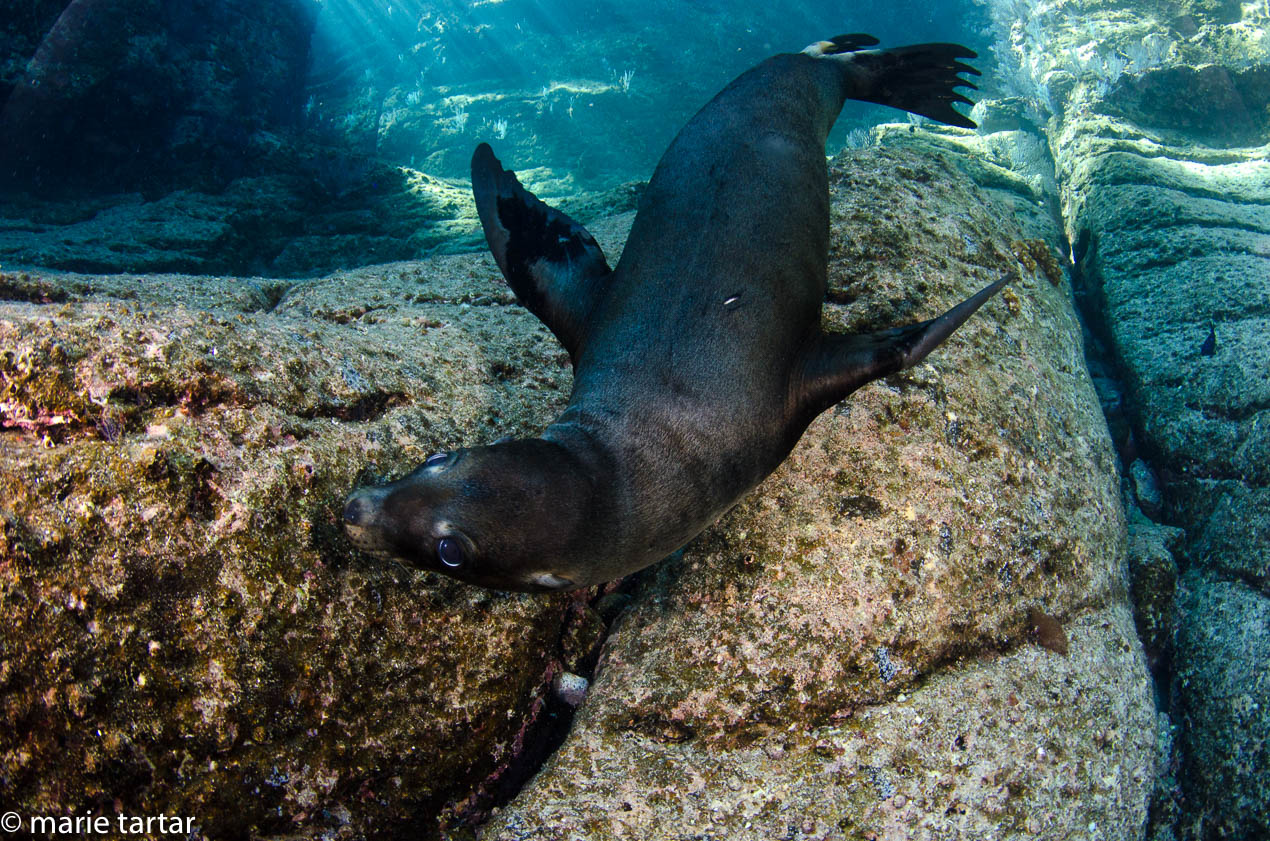
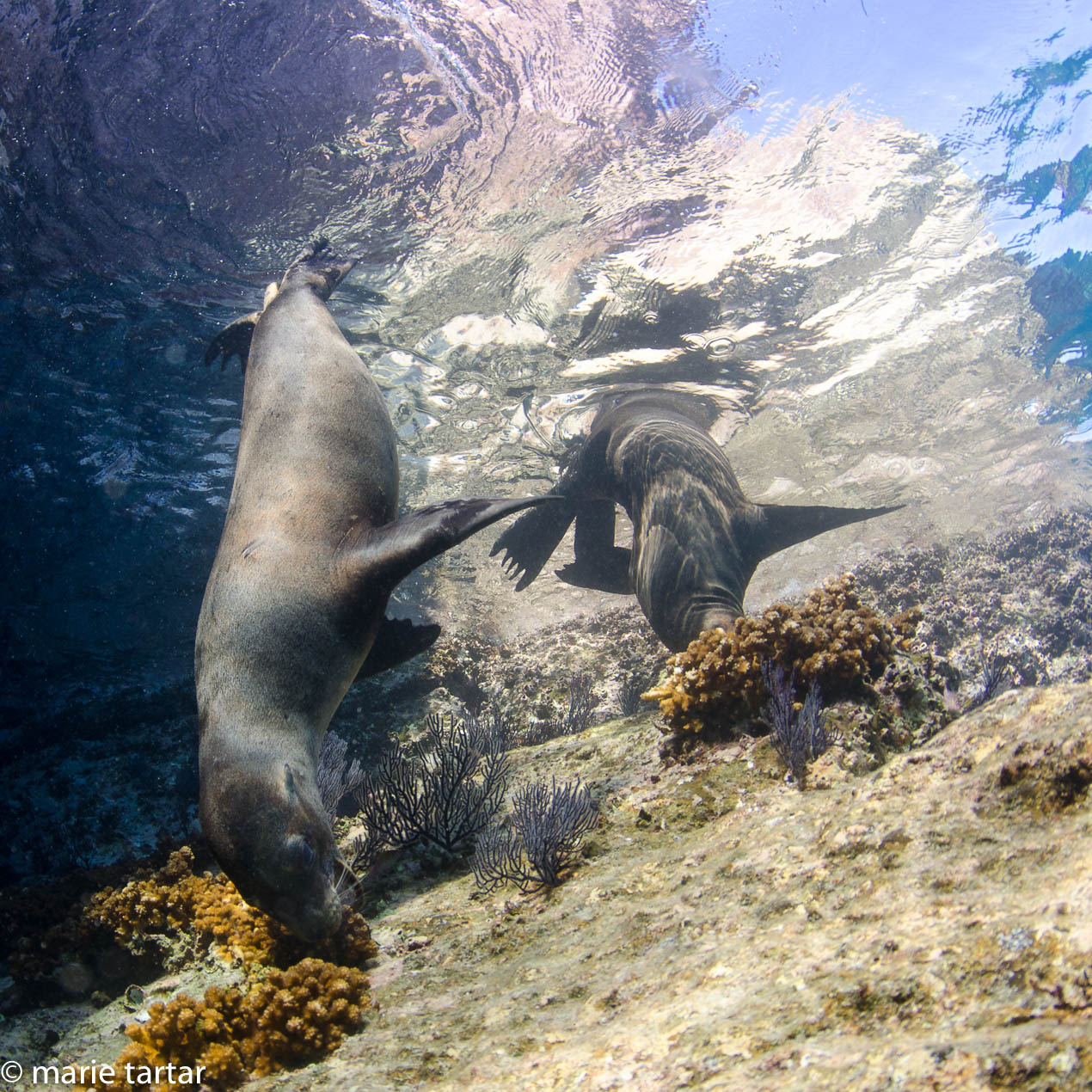

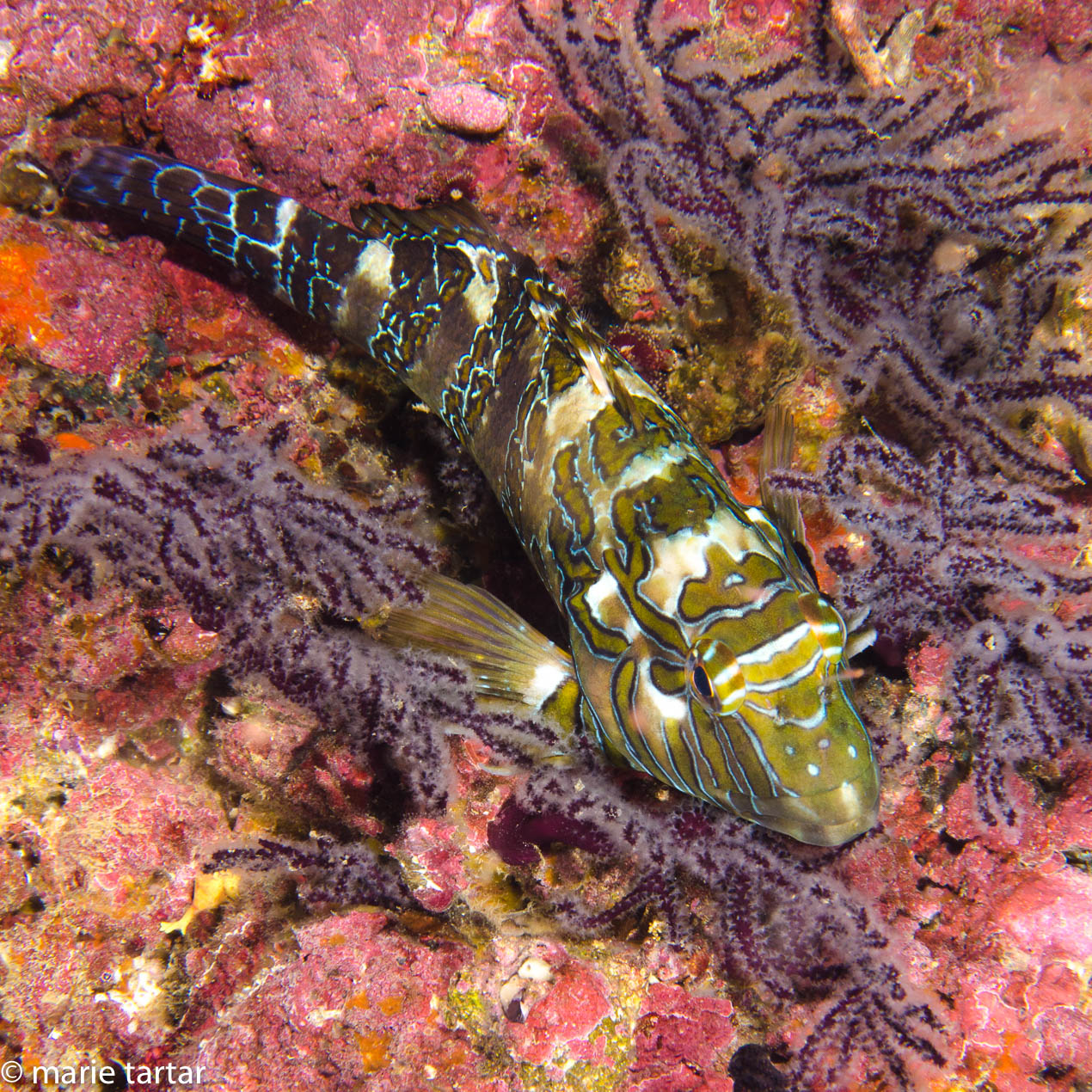
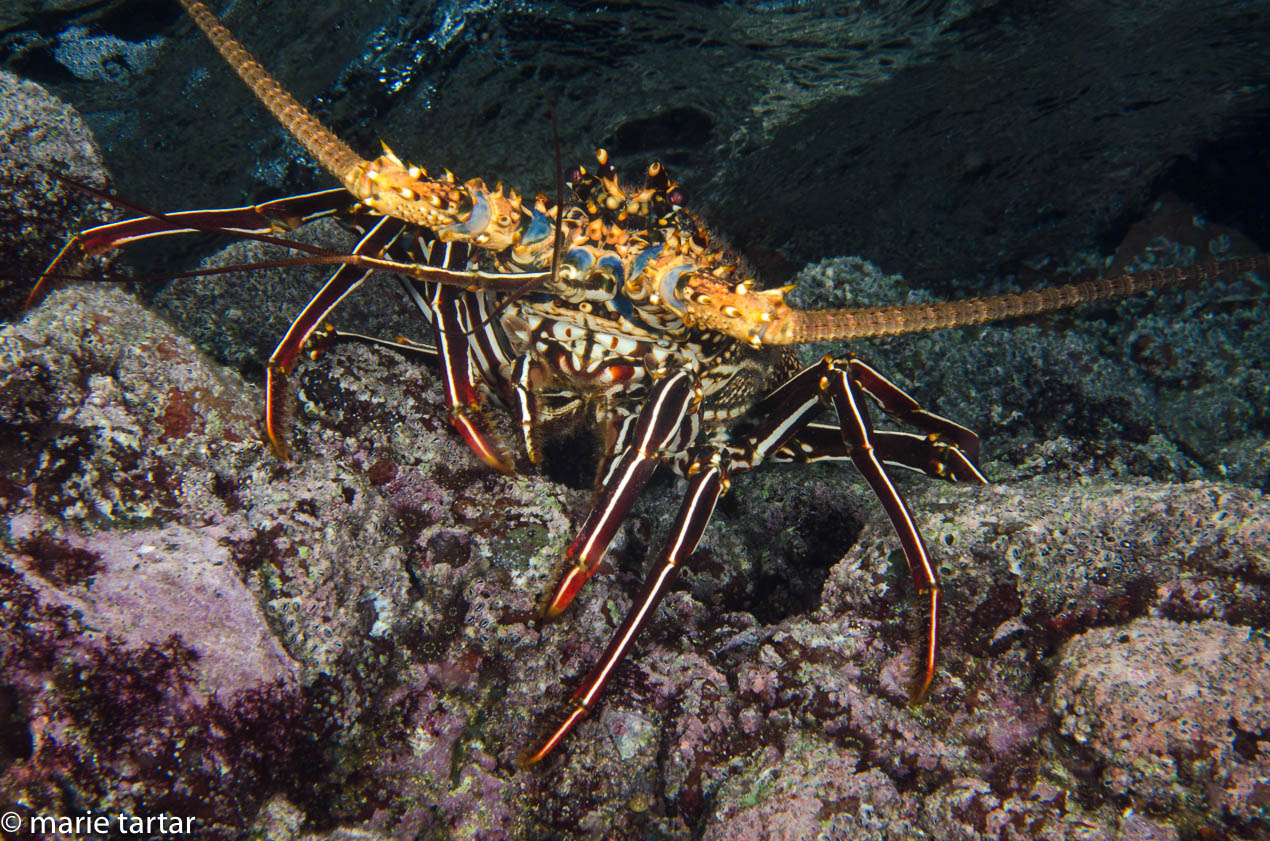
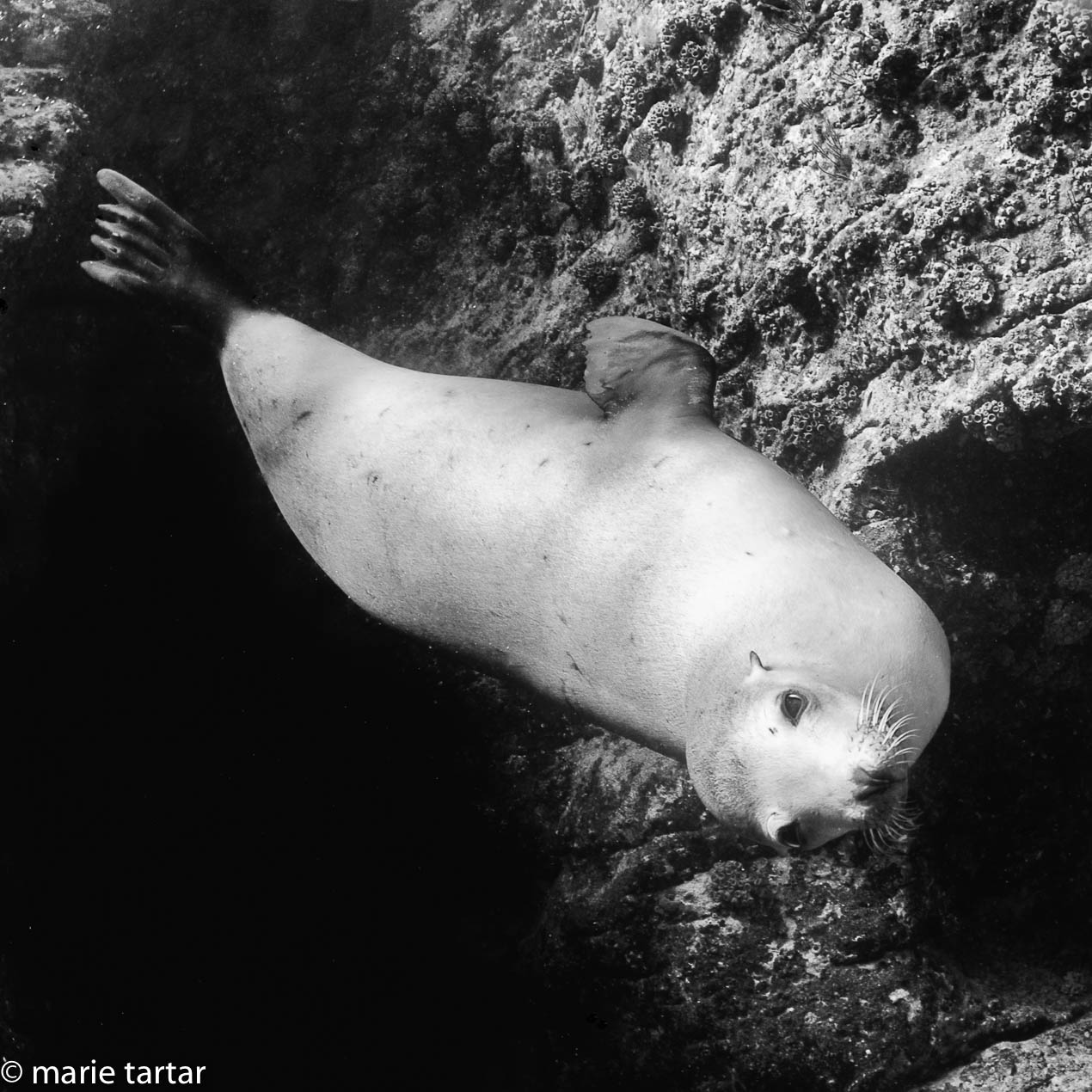

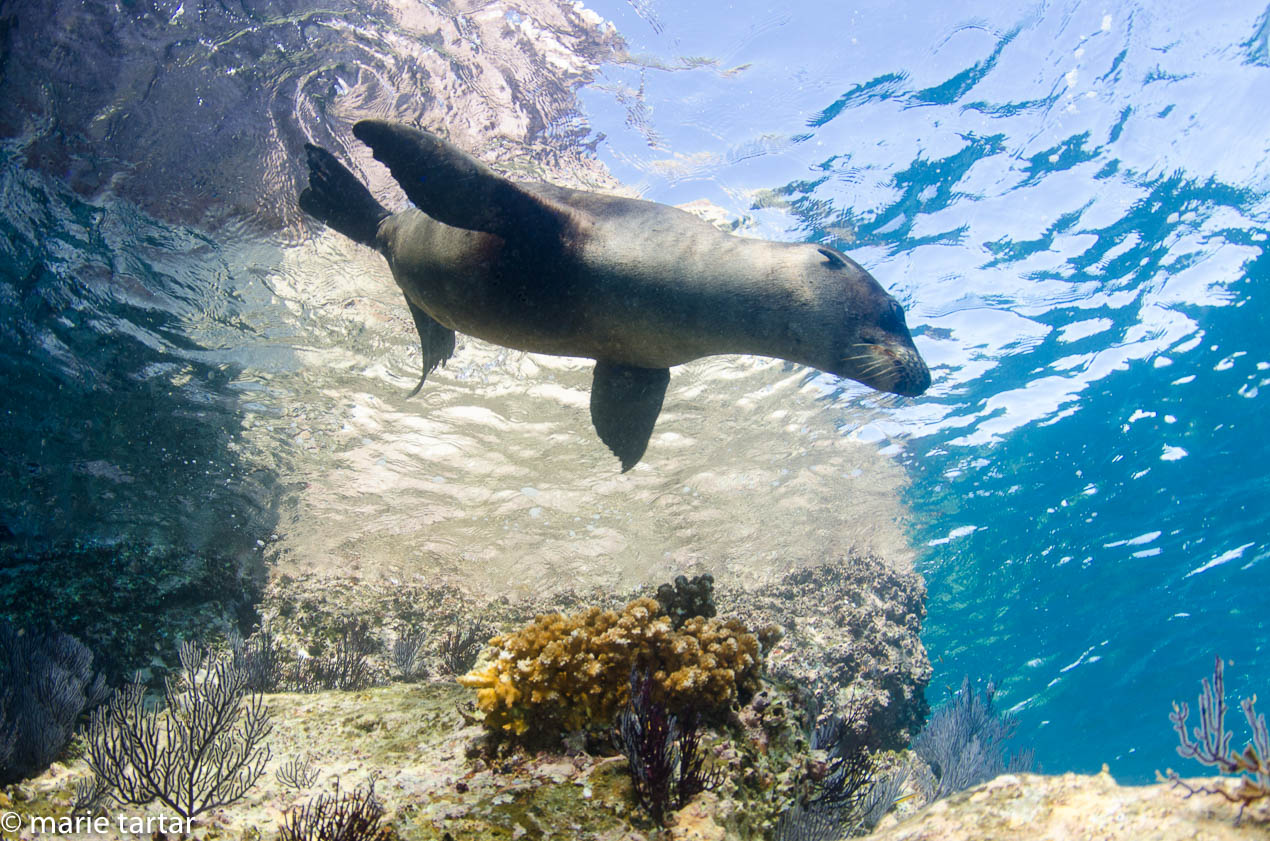
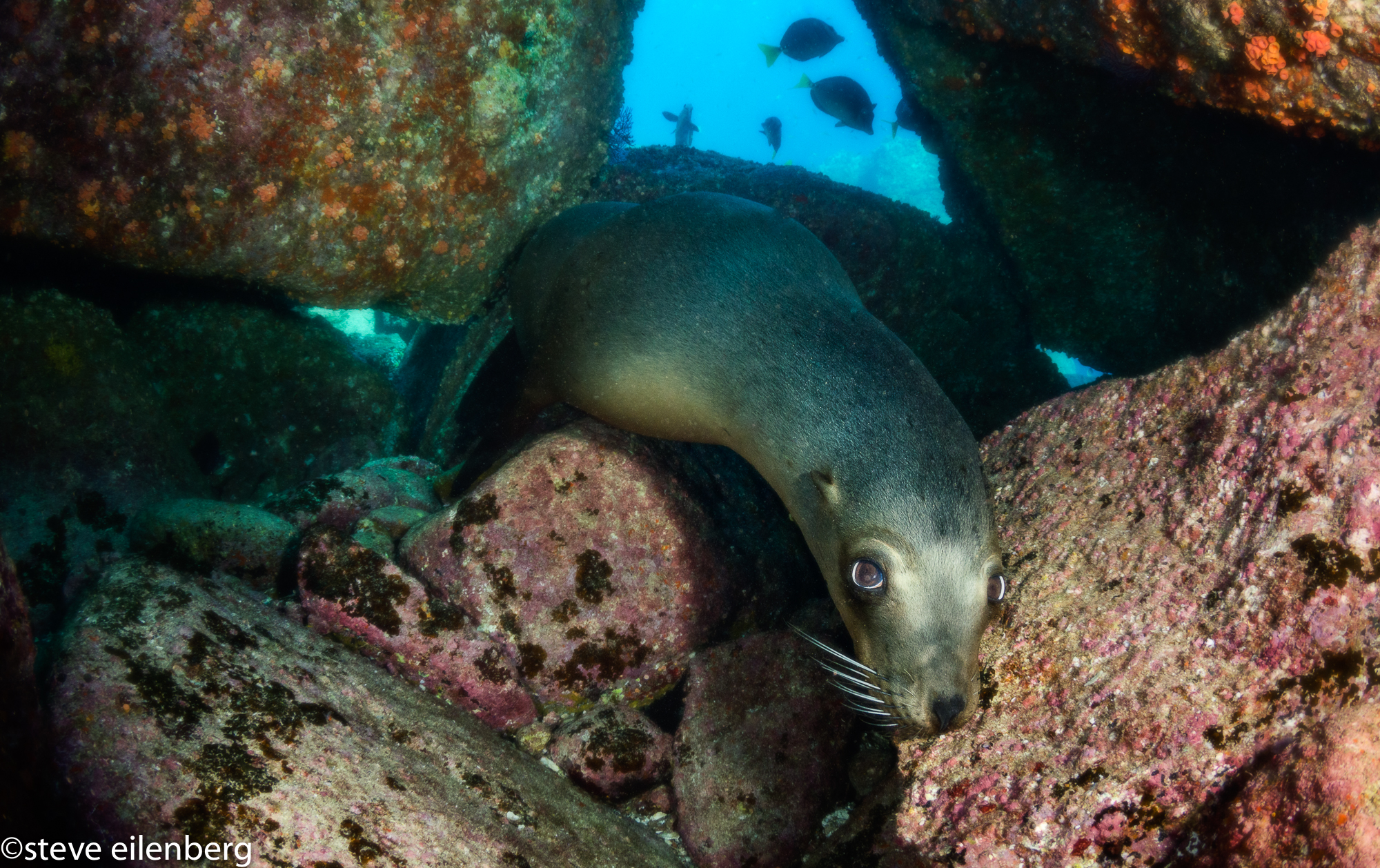

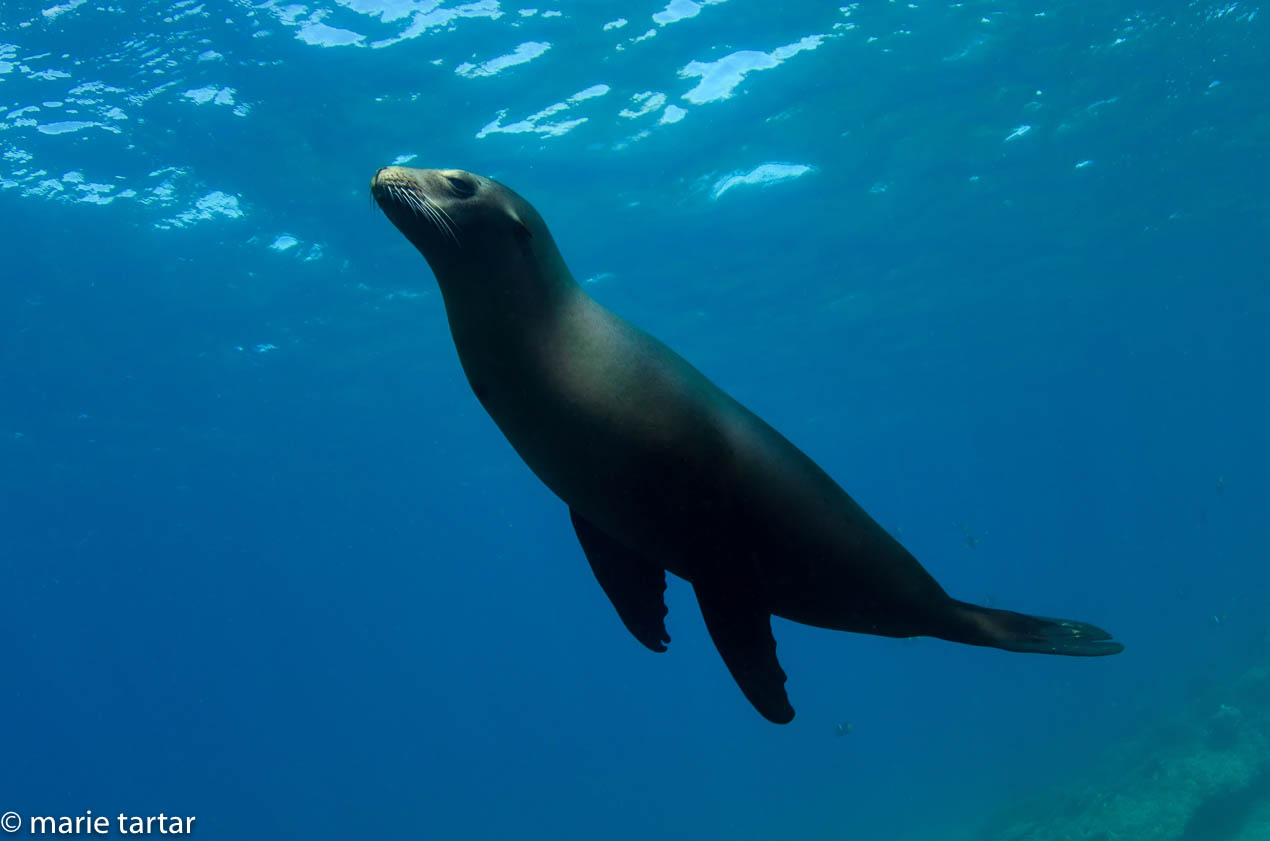
Really great pics! Just wanted to mention that I believe what you have identified as a “golden tufted tube blenny ((Mccoskerichthys sandae)” is actually a plume blenny (Cirriemblemaria lucasana). https://biogeodb.stri.si.edu/sftep/en/thefishes/species/1879 They seem to come in translucent yellowish or pinkish to red. https://biogeodb.stri.si.edu/bioinformatics/dfm/metas/view/27454 Here is a pic I took recently off Loreto, BCS https://flic.kr/p/2nxSTY4. I was trying to identify this species which is how I stumbled across your post. This would also explain why the Human and Deloach Reef Fish ID book says they are absent in the Gulf of California (Sea of Cortez).
Thanks for the correction, Dave and nice shot!
-Marie